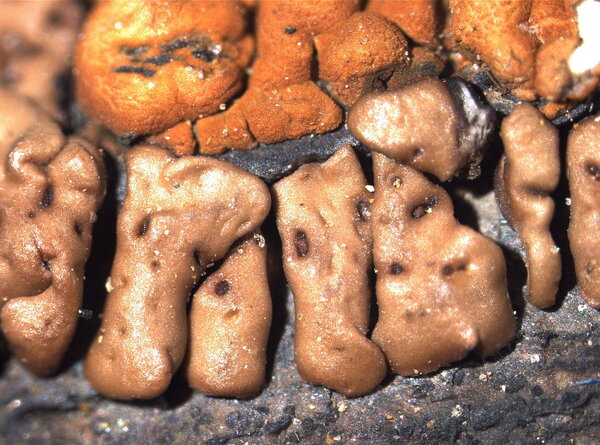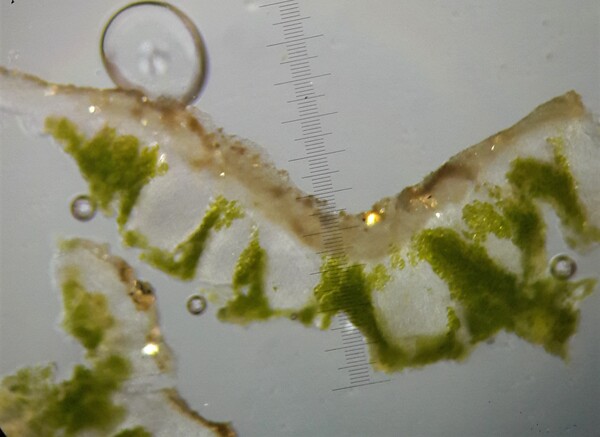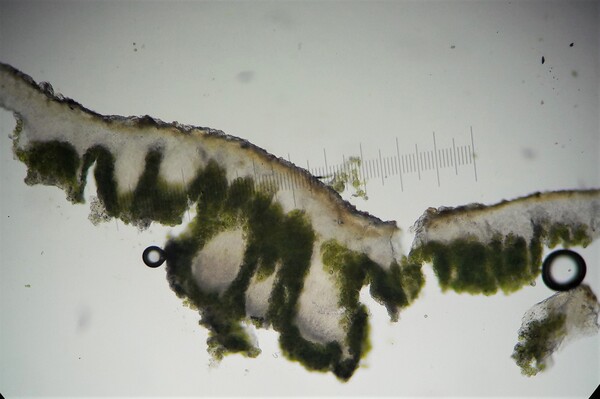Myriospora myochroa (M. Westb.) K. Knudsen & Arcadia
in Linda in Arcadia & Knudsen, Opuscula Philolich., 11: 22, 2012. Basionym: Silobia myochroa M. Westb. - Lichenologist, 43: 14, 2010.
Synonyms: Acarospora lesdainii auct. non Harm.; Acarospora smaragdula subsp. lesdainii auct. non (Harm.) Clauzade & Cl. Roux
Distribution: N - Frl (Tretiach & Hafellner 2000, Knudsen & al. 2017), TAA (Nascimbene & al. 2022), Piem, Lig. S - Cal (Puntillo 1996), Si.
Description: Thallus crustose to subsquamulose, episubstratic, grey-brown to dark brown-black, rarely grey-white, areolate, the areoles scattered to contiguous (0.6-)1-2.5(-5) mm wide, sometimes becoming subsquamulose, flat to strongly convex, epruinose; lower surface pale, ecorticate. Epinecral layer 5-30(-45) μm thick; cortex 30-60 μm thick, with crystals of norstictic acid visible in polarized light/phase contrast, the uppermost part with pale brown, 2-4(-5) μm wide cells, ), the lower part intergrading into a colourless prosoplechtenchyma that merges with the medulla; algal layer interrupted by thick anticlinal bundles of medullary hyphae. Apothecia lecanorine, immersed, 1-4(-14) per areole, 0.2-0.7 mm across, with a concave to flat, brown to dark brown, uneven disc, and a thin thalline margin. Proper exciple colourless, c. 30 μm thick below the hymenium, widening to up to 90 μm in upper part; epithecium brown; hymenium colourless, 120–230 μm high; paraphyses 1-1.5 μm thick at mid-level, the apical cells hardly swollen, to 2 μm wide; hypothecium colourless to yellowish grey, inspersed with oil droplets, 70-90 μm high. Asci 100-200-spored, narrowly clavate, the apical dome K/I-. Ascospores 1-celled, hyaline, narrowly ellipsoid, 3-5 x 1-1.5 μm. Pycnidia rare, immersed. Conidia ellipsoid, c. 2 x 1 μm. Photobiont chlorococcoid. Spot tests: thallus K+ or K+ dirty yellow (mostly in fresh material), C-, KC-, P- or P+ yellow, UV-. Chemistry: norstictic acid in very small amounts, detectable only by TLC, and not in all samples.Note: on rain-sheltered surfaces of metal-rich siliceous rocks in upland areas; probably more widespread in the Alps and occurring also in the Mediterranean mountains. This taxon was erroneously called M. hassei by Nimis (2016).
Growth form: Crustose
Substrata: rocks
Photobiont: green algae other than Trentepohlia
Reproductive strategy: mainly sexual
In underhangs rarely wetted by rain
Species of metal-rich rocks
Commonnes-rarity: (info)
Alpine belt: very rare
Subalpine belt: rare
Oromediterranean belt: extremely rare
Montane belt: extremely rare
Submediterranean belt: absent
Padanian area: absent
Humid submediterranean belt: absent
Humid mediterranean belt: absent
Dry mediterranean belt: absent
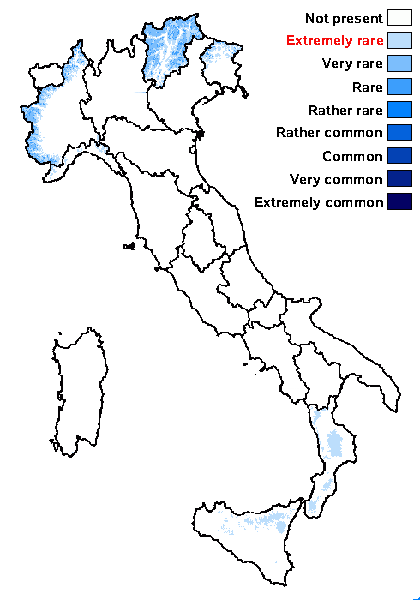
Predictive model
Herbarium samples


P.L. Nimis; Owner: Department of Life Sciences, University of Trieste
Herbarium: TSB (24565)
2001/12/12
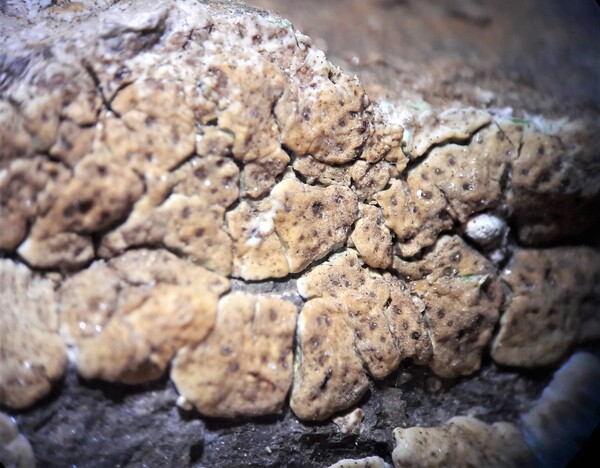

Juri Nascimbene CC BY-SA 4.0
Italy, Trentino-Alto Adige, Cima Valcigolera - Paneveggio (TN) 2330 m su scisti in strapiombo 2022
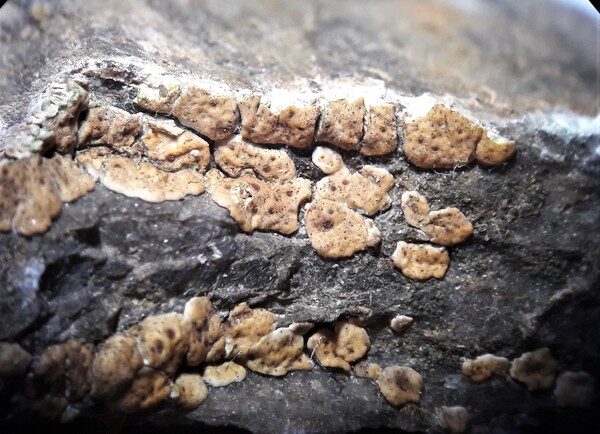

Juri Nascimbene CC BY-SA 4.0
Italy, Trentino-Alto Adige, Cima Valcigolera - Paneveggio (TN) 2330 m su scisti in strapiombo 2022
Growth form: Crustose
Substrata: rocks
Photobiont: green algae other than Trentepohlia
Reproductive strategy: mainly sexual
In underhangs rarely wetted by rain
Species of metal-rich rocks
Commonnes-rarity: (info)
Alpine belt: very rare
Subalpine belt: rare
Oromediterranean belt: extremely rare
Montane belt: extremely rare
Submediterranean belt: absent
Padanian area: absent
Humid submediterranean belt: absent
Humid mediterranean belt: absent
Dry mediterranean belt: absent

Predictive model
| Herbarium samples |


P.L. Nimis; Owner: Department of Life Sciences, University of Trieste
Herbarium: TSB (24565)
2001/12/12


Juri Nascimbene CC BY-SA 4.0
Italy, Trentino-Alto Adige, Cima Valcigolera - Paneveggio (TN) 2330 m su scisti in strapiombo 2022


 Index Fungorum
Index Fungorum
 GBIF
GBIF
